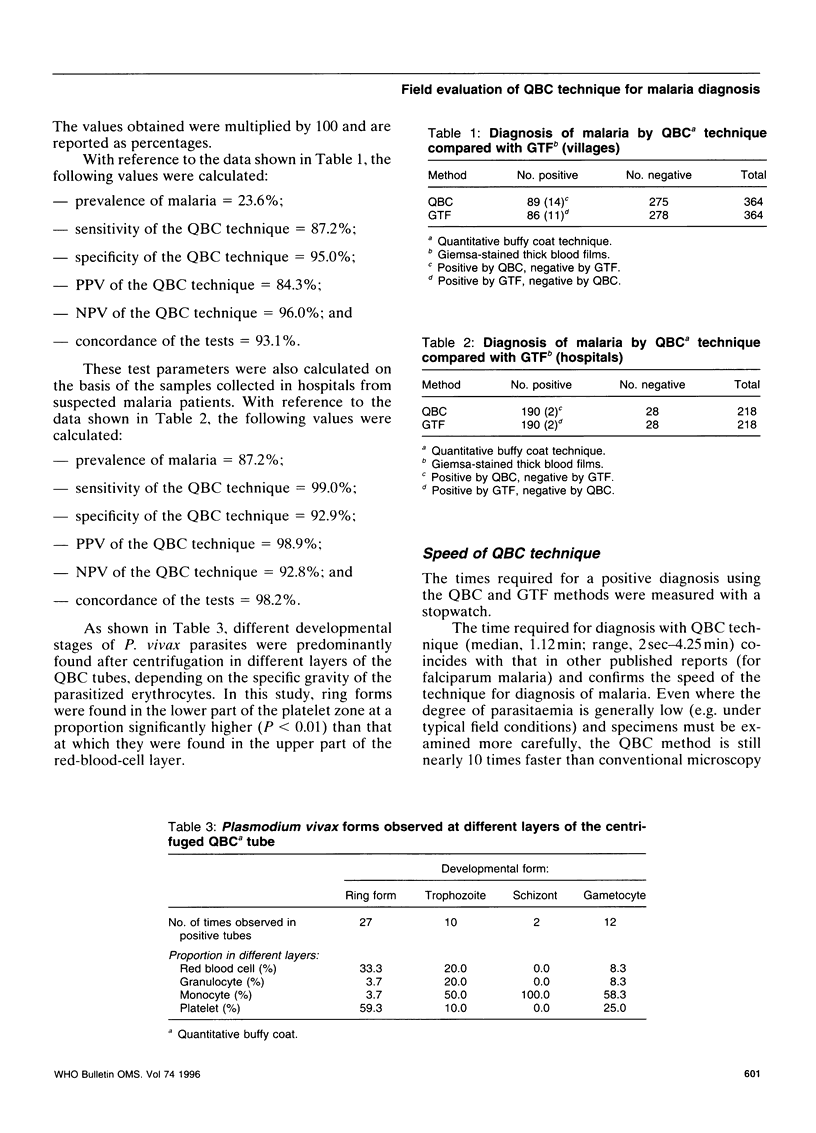Abstract
The QBC (quantitative buffy coat) technique was compared with that of the Giemsa-stained thick blood film (GTF) under field conditions in Junlian and Mingshan counties, Sichuan, China, for rapid diagnosis of vivax malaria. Blood samples were collected from 364 volunteer villagers, and each sample was examined with both the QBC and GTF techniques. For each GTF sample (10 microliters of blood), as many as 300 oil-immersion fields were examined; each QBC tube was inspected for up to 5 minutes. The GTF technique resulted in 86 positive blood samples and 278 negative; the QBC technique indicated 89 positive and 275 negative samples. Relative to the results obtained with GTF, the QBC technique had a sensitivity and specificity of 87.2% and 95.0%, respectively; concordance between the tests was 93.1%. The median time-to-positive diagnosis with the QBC technique (1.12 min) was 11% of that with GTF. The distribution of different developmental stages of Plasmodium vivax parasites was also examined in the centrifuged QBC tubes: all stages except schizonts could be found in the lower part of the platelet zone (the interphase between the monocyte and platelet layers), especially ring forms.
Full text
PDF




Selected References
These references are in PubMed. This may not be the complete list of references from this article.
- Baird J. K., Purnomo, Jones T. R. Diagnosis of malaria in the field by fluorescence microscopy of QBC capillary tubes. Trans R Soc Trop Med Hyg. 1992 Jan-Feb;86(1):3–5. doi: 10.1016/0035-9203(92)90412-6. [DOI] [PubMed] [Google Scholar]
- Barker R. H., Jr, Suebsaeng L., Rooney W., Wirth D. F. Detection of Plasmodium falciparum infection in human patients: a comparison of the DNA probe method to microscopic diagnosis. Am J Trop Med Hyg. 1989 Sep;41(3):266–272. [PubMed] [Google Scholar]
- Kawamoto F., Billingsley P. F. Rapid diagnosis of malaria by fluorescence microscopy. Parasitol Today. 1992 Feb;8(2):69–71. doi: 10.1016/0169-4758(92)90093-h. [DOI] [PubMed] [Google Scholar]
- Makler M. T., Ries L. K., Ries J., Horton R. J., Hinrichs D. J. Detection of Plasmodium falciparum infection with the fluorescent dye, benzothiocarboxypurine. Am J Trop Med Hyg. 1991 Jan;44(1):11–16. doi: 10.4269/ajtmh.1991.44.11. [DOI] [PubMed] [Google Scholar]
- Rickman L. S., Long G. W., Oberst R., Cabanban A., Sangalang R., Smith J. I., Chulay J. D., Hoffman S. L. Rapid diagnosis of malaria by acridine orange staining of centrifuged parasites. Lancet. 1989 Jan 14;1(8629):68–71. doi: 10.1016/s0140-6736(89)91428-1. [DOI] [PubMed] [Google Scholar]
- Saul A., Myler P., Elliott T., Kidson C. Purification of mature schizonts of Plasmodium falciparum on colloidal silica gradients. Bull World Health Organ. 1982;60(5):755–759. [PMC free article] [PubMed] [Google Scholar]
- Spielman A., Perrone J. B., Teklehaimanot A., Balcha F., Wardlaw S. C., Levine R. A. Malaria diagnosis by direct observation of centrifuged samples of blood. Am J Trop Med Hyg. 1988 Oct;39(4):337–342. doi: 10.4269/ajtmh.1988.39.337. [DOI] [PubMed] [Google Scholar]


